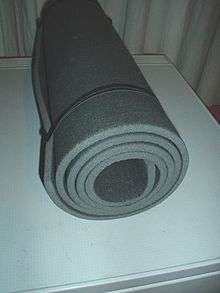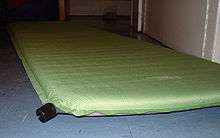Sleeping pad

In camping, a ground pad, sleeping pad, sleeping mat, roll mat, or iso mat is a simple device often used in conjunction with a sleeping bag. Its purpose is to provide padding and thermal insulation. All types currently available use air as their primary form of insulation.
Inflating types
Manually inflated
Closely related to the air mattress a pad of this type requires an external pressure source to inflate, typically in the form of a pump or by blowing orally.[1] Convection of the air inside the mattress reduces the amount of insulation it provides and more complicated mattresses include methods to reduce this by either partitioning the internal cavities, or by filling the cavities with material to trap the air such as down feathers or synthetic insulation.

Self inflating
An extension on the conventional manually inflated mattress, this type is capable of self-inflation due to the open-cell foam that fills the internal cavity. For many years this design was protected by various patents held by Cascade Designs[2] and they were an unusual and premium item. But since these patents expired many other manufacturers are now producing this type of mattress and they are now commonplace. These mattresses are lightweight and pack to a small size, which make them popular amongst hikers and campers.[3] A self-inflating mat typically measures 183x51x3.8 cm, weighs about 700 g, and packs to about 28x16 cm.
Foam types
Closed-cell foam is used to produce mats that can be used without requiring any inflation. Closed-cell foam pads are lighter and more durable than their air-filled counterparts, as they are constructed of fewer materials. Many may also be trimmed to size should the user choose to do so. However, they are generally not as comfortable as air-filled mats because they are thinner, and may also take up more space in a pack, depending on the materials used. Variations include textured or shaped foam to increase the unrolled volume and/or change the stiffness of the mattress. This can also be used to trap the air within ridges or an egg-carton type of texture.
See also
| Look up camping mat in Wiktionary, the free dictionary. |
References
- ↑ "How to Choose a Sleeping Pad". Eastern Mountain Sports. Retrieved 13 February 2015.
- ↑ Lea et al. 1979. Method of making a self-inflating air mattress. 4,149,919.
- ↑ "Sleeping Pads – Types and Uses". Slumber Sage. Retrieved 13 February 2015.